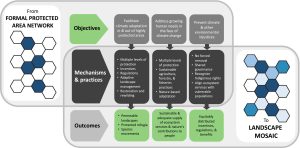Whole-Earth: A Conservation-Planning Paradigm for a Changing Climate
Citation
Lawler, J. J., Gross, J. E., Foden, W. B., & Midgley, G. F. (2025). Whole‐Earth: A Conservation‐Planning Paradigm for a Changing Climate. Global Change Biology, 31(7), e70328. doi.org/10.1111/gcb.70328
Conservationists support protecting 30%–50% of the earth’s surface to help solve the ongoing problems of biodiversity loss and climate change. However, just expanding protected areas won’t be enough to tackle challenges like shifting species, changing ecosystems, rising human demands, and environmental injustices. Instead, conservation efforts should focus on creating conservation mosaics. These are large, connected landscapes and seascapes that combine different levels of protection and management. This approach can improve coordination of conservation work, make it easier for species to move, support healthy human communities, and reduce environmental harm. This paper outlines a plan for developing conservation mosaics to better meet both biodiversity and human needs.
Abstract

Conservationists have called for conserving 30%–50% of the earth’s surface to address the ongoing biodiversity and climate crises. To be successful, such an expansion of the global reserve network must meet climate-intensified challenges of species movements, ecological transformations, increasing human needs, and environmental injustices. These challenges will not be overcome by simply doubling or tripling the footprint of protected areas. Instead, successful biodiversity conservation will require planning for conservation mosaics—large, integrated landscapes, and seascapes composed of areas with different levels of protection and types of management—that cover the entire earth. Such mosaics can (1) increase landscape-scale coordination of conservation efforts, (2) increase landscape permeability, (3) sustain healthy human populations, and (4) reduce environmental injustices. We describe this more holistic spatial conservation paradigm and provide a framework for planning for conservation mosaics that addresses growing biodiversity conservation and human needs.